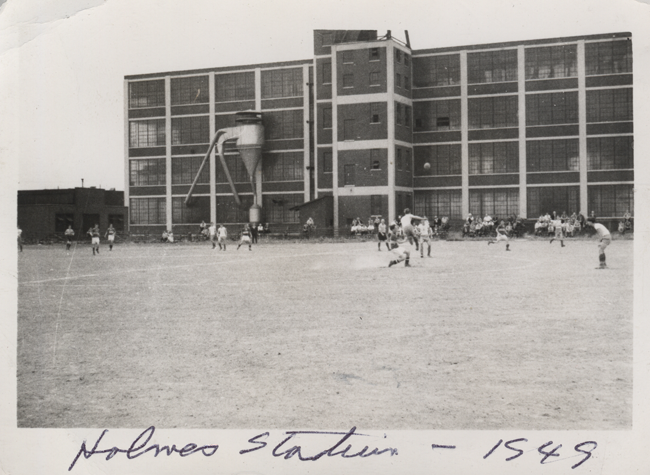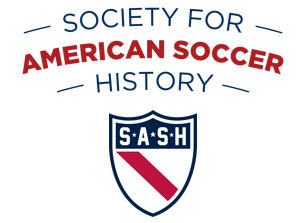
Last week we published the first part in Philadelphia-born National Soccer Hall of Famer Len Oliver’s series about his memories of playing soccer in the 1940s and 1950s. We follow that with the first in a series of Q&As with Oliver, who now lives in Washington DC, to go a little deeper into the Philadelphia soccer scene in the 1940s and 1950s.
Part 1: Philadelphia soccer in the 1940s and 1950s
SASH: When did your father come to the States? Did he play club soccer in Scotland?
Len Oliver: My Father, Jim Oliver, came over from Scotland in 1923. My father was 23 when he came over. He was born in Bells Hill, Scotland, near Motherwell, the town that Matt Busby made famous.
He went straight to the Blue Bell’s Soccer Club, made the soccer team in Philly’s 1st Division Amateur, and they found him a job. The immigrant experience!
SASH: When did your father stop playing?
LO: He played until the late 1930s, approaching 40 years of age. I remember as a youngster his coming off the field full of mud. My twin, Jim, and I would kick around a ball behind the Bluebell’s bench.
SASH: Am I correct that you eventually played for Kensington Blue Bells too? How old were you when you started playing for them?
LO: I was 16 in my first game with them, and they put me at center half in the old “two-back game.” It was heady and an honor for a young player. This was 1st Division Amateur, just below the pros, and we played against mainly adult immigrants who knew the game. As soon as the high school, and then Temple’s seasons ended, we went straight to the Blue Bells, winning the Palmer Cup several years as well as the League.
SASH: Can you tell me more about the Kensington Blue Bells? Where did they train and play? Those blue and white uniforms, were they hoops or stripes?
LO: The uniforms were horizontal stripes, reminiscent of the old country. We trained in local gyms or at the Lighthouse Boys’ Club Fields at B Street and Erie Avenue. We didn’t practice often together as most of us were playing school ball throughout the week. We really didn’t have a coach. We called him a “Manager” who just put us on the field.
SASH: I get the sense that soccer provided immigrants a chance to connect with friends, and maintain a connection with their roots, while finding their place in a new land. That can be hard anytime, but especially so in during the tough times of the Depression.
LO: My father came over prior to the Great Depression, always finding work, mostly odd jobs—delivering ice, bartending, handyman. But soccer did bring him a social network. When his twin sons were born in 1933 (Jim and Len), he vowed they would be soccer players.
SASH: You describe a Philadelphia soccer landscape with many ethnic clubs but how the city still nurtured a sizeable number of homegrown talent. Was soccer viewed as an “immigrant” sport or was it viewed as just a part of the Philadelphia sport landscape?
LO: Both. Soccer was viewed as an “immigrant sport” throughout the country, especially in large urban areas where the immigrants had their ethnic clubs for socializing, job-finding, schools, language training, music, and of course soccer teams—from juniors through the senior ranks.
SASH: You describe how you and your brother looked forward to seeing the pros of the ASL play. How did you follow them? Was there much newspaper or radio coverage of the league? Were there magazines that covered the league and the players?
LO: No magazine coverage, except for the occasional soccer publication like Bill Graham’s publication, something like “Soccer Journal,” but I am not sure. We went to most of the American Soccer League (ASL) games, usually played on Sundays at either Holmes Stadium on Erie Avenue and at Cambria Stadium on Kensington Avenue at Erie Avenue. After the pro games, we would go into the street (Helen Street) and imitate the moves of the pros, thereby adding to our emerging repertoire of soccer moves. We also had our heroes in the pros.
SASH: Soccer specific stadiums have been a big part of the success of MLS. Can you tell me more about Cambria Stadium where the Philadelphia Americans played? How about Philadelphia Nationals and Holmes Stadium?
LO: Cambria Stadium was used for many events, and I believe it was a city-owned property. Holmes Stadium, on Erie Avenue, sat next to the Holmes Knitting Mill, owned by the Mill. In the amateur ranks with the Kensington Bluebells, we played throughout the city, many times on cinder fields (Kensington Recreation Center) or on dirt fields. It was always a joy to play against Erzgebirge or the German Hungarians as they had splendid soccer-only grass fields.
SASH: This may be me misreading what you wrote, but you write “Opposing players who stayed with us were Jackie Hynes with the New York Americans and John ‘Clarkie’ Souza of Fall River.” Did they actually stay with your family? I ask because later you describe being a semi-pro player yourself and traveling to games and I wonder what it was like traveling to road games – how you traveled, where you stayed, and so on.
LO: Hynes and Souza, later in life, became my friends through our mutual induction into the National Soccer Hall of Fame. They never stayed with us in our small row-house in Kensington, the phrase was meant to mean we followed their careers. For away games with the pros, we always traveled by private car—to Trenton, to New York City, to Pittsburgh, to Baltimore, to New Bedford, to Fall River, and so on. One of the players usually drove.
Once in a while, at a particularly intense away game, e.g., in Brooklyn or Queens, we would bring the cars, motors running. to the edge of the field so we could get out quickly in case of fan trouble. And it occasionally happened.
SASH: When you first wrote your article in 1992, you describe both how when it comes to coaching young players “too much individualism is suspect, and kids are coached, or at times over coached, in the ‘proper techniques.'” Do you still see that being a problem 20 years later?
LO: Yes, “over-coaching” is still prevalent. Our parent-coaches borrow from baseball and football, thinking they have to instruct youngsters at every stage, when in reality, the game is the “great teacher.” I did not play on a formal team until I was 10 years old, having played in the streets and in our local cemetery (yes, with tombstones as goal posts) with my brother and neighbor kids from 5 years old up. By 17, I was in the U.S. Olympic Finals in St. Louis (1952) and was the youngest player ever in the finals. I made alternate, was told to come back in 4 years, and that’s another story.
SASH: You emphasize that being able to see high-level soccer as a kid so that you could learn by emulating what great players did on the field was a crucial part of how you learned to play and love the game. Do you have a sense that the growth of MLS and access to games from around the world on TV and online for kids to follow has helped player development?
LO: Yes, seeing the pros play in person and on TV allows youngsters to emulate the moves on of the pros, aspire to be pros themselves, and teaches them about the game. This is especially true if kids see the games in person, guided by a knowledgeable parent or coach.
A version of this Q&A first appeared at the Philly Soccer Page on December 12, 2012
